IMDEA Networks

Archives: Events
Reconstructing Barabasi-Albert networks in the number-in-hand computation model
Suppose that we have a network of n processors where each processor knows its own ID and the IDs of its neighbors. Processors communicate in synchronous rounds by writing messages on a whiteboard, which is visible to all of them. The goal is to design a protocol at the end of which every processor knows the topology of the network.
Read more arrow_right_altArchitecting an Evolvable Internet with XIA
Motivated by limitations in today's host-centric IP network, several recent "clean-slate" network architectures have proposed alternate first-class principals, such as content, services, or users.
Read more arrow_right_altPh.D. Thesis Defence: Quid Pro Quo: Mecanismos para la asignación de tareas en entornos distribuidos
En este trabajo proponemos una solución para la asignación de tareas en un entorno distribuido complejo y auto-organizado (sería el caso de las redes entre iguales o ́ P2P). Estamos interesados en las tareas que son comunes a todos los participantes o nodos del sistema. Cada uno de los nodos puede ejecutar estas tareas y, además, está interesado en que éstas se ejecuten. Cada nodo dispone de capacidad para la ejecución de cada una de las tareas. El coste para cada nodo es una información que no puede ser auditada y que es únicamente conocido por el nodo en cuestión. Suponemos que los nodos pueden mentir sobre su coste si eso les supone un beneficio; por ejemplo, por el ahorro que implicaría verse libre de ejecutar las tareas.
Read more arrow_right_altMeasuring the Impact of Adversarial Errors on Packet Scheduling Strategies
In this paper we explore the problem of achieving efficient packet transmission over unreliable links with worst case occurrence of errors. In such a setup, even an omniscient offline scheduling strategy cannot achieve stability of the packet queue, nor is it able to use up all the available bandwidth. Hence, an important first step is to identify an appropriate metric for measuring the efficiency of scheduling strategies in such a setting. To this end, we propose a relative throughput metric which corresponds to the long term competitive ratio of the algorithm with respect to the optimal. We then explore the impact of the error detection mechanism and feedback delay on our measure. We compare instantaneous error feedback with deferred error feedback that requires a faulty packet to be fully received in order to detect the error. We propose algorithms for worst-case adversarial and stochastic packet arrival models, and formally analyze their performance. The relative throughput achieved by these algorithms is shown to be close to optimal by deriving lower bounds on the relative throughput of the algorithms and almost matching upper bounds for any algorithm in the considered settings. Our collection of results demonstrates the potential of using instantaneous feedback to improve the performance of communication systems in adverse environments.
Read more arrow_right_altSeparating Wheat from Chaff: Winnowing Unintended Prefixes using Machine Learning
In this paper, we propose the use of prefix visibility at the interdomain level as an early symptom of anomalous events in the Internet. We focus on detecting anomalies which, despite their significant impact on the routing system, remain concealed from state of the art tools. We design a machine learning system to winnow the prefixes with unintended limited visibility – symptomatic of anomalous events – from the prefixes with intended limited visibility – resulting from legitimate routing operations.
Read more arrow_right_altResearch in Collaborative Haptic-Audio-Visual Environments
Multimedia and information technology are reaching limits in terms of what can be done in multimedia applications with only sight and sound. The next critical step is to bring the sense of “touch” over network connections, which is commonly known as Tele-haptics. Haptics, a term which was derived from the Greek verb “haptesthai” meaning “to touch”, introduces the sense of touch and force into the human-computer interaction. Currently, research on haptics is broadly categorized into human haptics, machine haptics, and computer haptics. Human haptics is mostly conducted by psychologists to study the mechanism of the “touch” modality, while machine haptics refers to the design of haptic devices to reproduce the sense of “touch”.
Read more arrow_right_altAdaptive Modulation for Finite-Horizon Multicasting of Erasure-coded Data
We design an adaptive modulation scheme to support opportunistic multicast scheduling in wireless networks. Whereas prior work optimizes capacity, we investigate the finite horizon problem where (once or repeatedly) a fixed number of packets has to be transmitted to a set of wireless receivers in the shortest amount of time -- a common problem, e.g., for software updates or video multicast.
Read more arrow_right_altUnderstanding the Reachability of the IPv6 Limited Visibility Prefixes
The main functionality of the Internet is to provide global connectivity for every node attached to it. In light of the IPv4 address space depletion, large networks are in the process of deploying IPv6.
Read more arrow_right_altLecture on Advanced topics in Internet Routing with BGP
The Border Gateway Protocol (BGP) is the protocol used among Internet Service Providers to provide IP connectivity among and across their networks. In this course, we will first review the basics of Internet routing with BGP.
Read more arrow_right_altHandoff Prioritization Schemes and TDMA Scheduling in Wireless Networks
Handoff is a key element in the wireless cellular networks in order to provide Quality of Service (QoS) to the users and to support users’ mobility. Handoff failure will result in the forced termination of an ongoing call. From the user’s point of view, the service of a handoff request is more important, as the forced termination of an ongoing call is more annoying than the blocking of new calls. Therefore, in order to support QoS to the users and to provide ubiquitous coverage, the handoff procedure should be further investigated. The aim of this lecture is to provide a comprehensive survey of the basic elements, the different types and phases of the handoff procedure.
Read more arrow_right_alt











Recent Comments